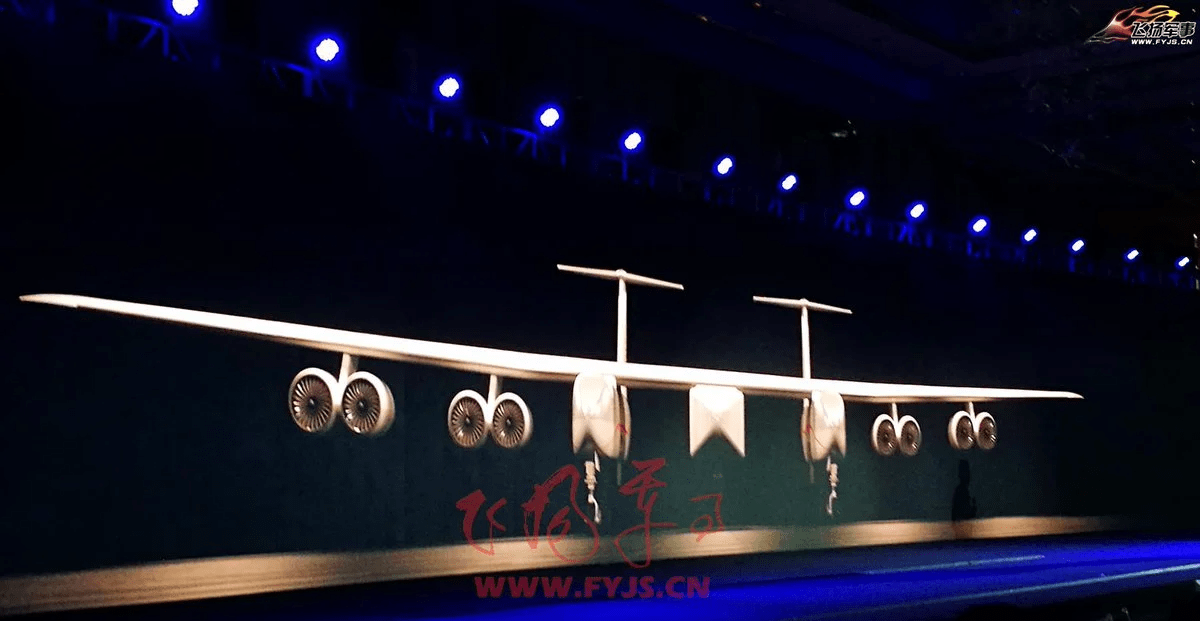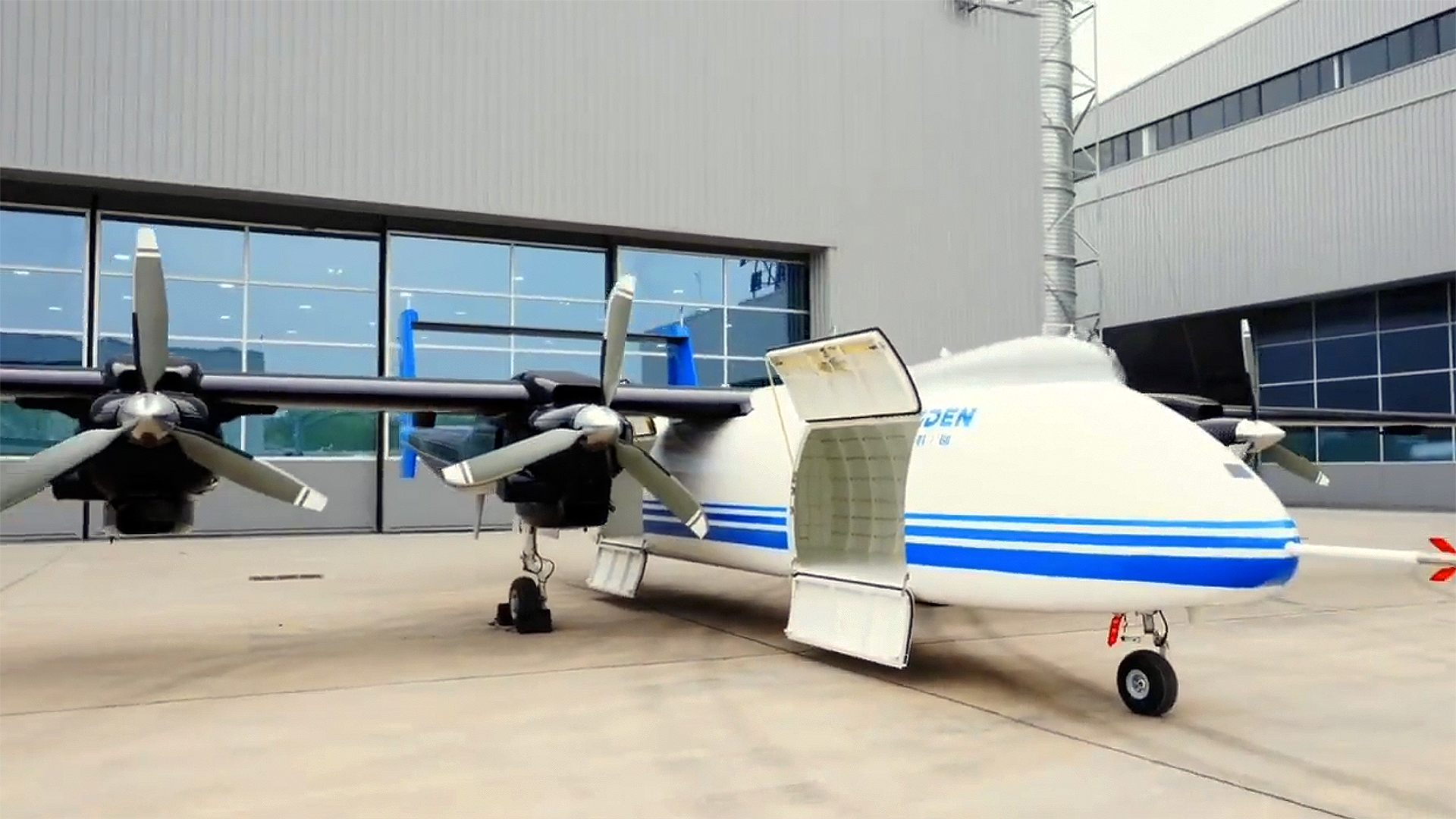A cargo drone dubbed TB0D Scorpion D and built by China’s Tengden Technology company completed its maiden flight in Sichuan on October 25. The company says Scorpion D will be able to carry payloads weighing up to 1.5 tons.
Scorpion D is equipped with four propellers driven by gas engines, two under each of its wings, which are fitted high atop the drone’s fuselage. The company has also shared the Scorpion D’s supposed technical specifications, which detail that the cargo drone clocks in at 34 feet (10.5 m) in length, stands at 10 feet (3.1 m) tall, and has a 65-foot (20 m) wingspan.

Along with its substantial payload capacity, reportedly up to 1.5 tons, Scorpion D’s maximum takeoff weight is 4.35 tons. Scorpion D’s cargo hold is said to measure out to about 31 square feet and about 5 cubic meters, which would leave ample room for a variety of equipment and supplies be it civilian or military depending on the use case.

It would also appear that the cargo drone will serve as another variant in a growing series of aircraft being produced by the company. This ‘family’ of Tengden drones began with a separate system designated as the TB-001 Scorpion medium-altitude, long-endurance (MALE) drone, which is also Tengden’s flagship aircraft. Considering that information about how exactly Scorpion D will be controlled and operated as well as the drone’s range doesn’t appear readily available, its progenitor’s specifications could be beneficial in better understanding how Scorpion D will perform once operational.

For instance, Tengden’s website claims that TB-001, with its two engines as opposed to Scorpion D’s four, has a range of about 3,728 miles (6,000 km) and a flight endurance of about 35 hours. While the site itself doesn’t detail how the drone is controlled, TB-001 reportedly features man-in-the-loop and semi-autonomous capabilities with an effective communication range of 173 miles (280 km) from the ground command post within line of sight. TB-001 can also utilize satellite communication data links, which would ostensibly extend the two-way communication distance potentially indefinitely.
The TB-001 Scorpion features a twin-boom tail similar to the Scorpion D but is instead powered by only two single propellor engines on either side of its fuselage under its straight, high-mounted main wing. The company has also produced a three-engine variant of the inaugural Scorpion meant to improve “wide-area deployment, short take-off and landing, high-altitude performance, [and] high-power power supply capability,” according to the company.
TB-001 was designed with the option to be armed or carry other external stores as opposed to carrying cargo. The aircraft features four underwing hardpoints that are capable of holding various missiles and precision-guided bombs and is also equipped with a sensor turret underneath its central fuselage, whereas neither addition can be immediately seen in the recently surfaced photos of the Scorpion D. TB-001 does, however, boast technical specifications similar to the Scorpion D, with a maximum takeoff weight of about 3 tons and similar size measurements.
According to Tengden’s website, the TB-001 “has successfully provided services for fields related to the national economy and people’s livelihood such as emergency rescue, regional logistics, materials delivery, and meteorology services, and blazed a trail of UAV commercialization in terms of UAV remote command, materials aerial delivery, route test flight, forest fire prevention and rescue, communication relay and typhoon observation.” While some of this may be true, the type is especially used for military applications.

In the past, The War Zone has highlighted how the TB-001 has been used by China’s People’s Liberation Army Air Force (PLAAF) to fly sorties just off the islands of Japan. These activities also confirmed that TB-001 is in operational use well beyond China’s borders, which would mean that its flight systems, sensors, and avionics are proven, at least to a sufficient enough degree for the PLA. The drones have since become a staple of PLAAF operations around Taiwan and over other highly-monitored stretches of airspace. So, Tengden already has established past experience and work to leverage while fleshing out Scorpion D’s design and concept of operations.
Tengden was founded in 2016 and is just one part of China’s booming multi-billion dollar unmanned aerial vehicle (UAV) industry. The company, which has promised to build the world’s biggest cargo drone, describes itself as a creator and provider of high-end unmanned aircraft that serve markets “such as global feeder logistics, emergency management, meteorological services, and other aviation applications and scientific research.” As is now clear, the ‘other’ applications include military activities.
In 2018, Popular Science divulged that Tengden had partnered with the Chinese delivery company SF Express to design an improved TB-001 specifically for cargo by boosting the drone’s size and payload. The article explained that this concept was demonstrated the year prior when the modified TB-001 para-dropped supplies to a Huawei repair crew in the Yunnan Province.
Judging by Tengden’s ambitions, Scorpion D is only just the beginning, as well. While attending trade shows over the years, the company has presented its plans for an eight-engine drone with a wingspan of more than 137 feet and a payload capacity of 20 tons, which would be akin to a medium-sized manned cargo plane. The Popular Science article noted that Tengden was already in the process of building this behemoth when it was first announced, adding that the company intended for it to take its first flight in 2020, but that does not appear to have occurred.

Scorpion D will not be without competition, though. China is very active in the cargo drone market, with offerings ranging from the Star UAV System-designed AT200 heavy cargo UAV capable of carrying up to 1.5 tons of cargo to the First Aviation Institute-developed TP 500 cargo UAV which can accommodate a 1,102 lbs (500 kg) load. Each drone is reportedly being developed for both commercial and military applications.

While Scorpion D’s potential commercial applications are obvious and prominently highlighted by the company, the military opportunities are just as clear. China has all sorts of remote outposts, including on islands in the South China Sea and along its disputed borders with India. Depending on what kind of runway Scorpion D would require, the transport drone could help with resupplying far-flung garrisons and other more austere PLA military bases.
If its short-field performance is quite good, considering it sports four engines this seems likely, the type could become a highly flexible military resupply asset for small cargoes. The big question is how would this drone operate out of different airfields. While it could fly to its destination semi-autonomously, landing and taking off is a harder problem to solve, although it’s far from impossible. Even local launch and recovery elements could manually land and launch the drone, but doing so on autopilot would be a far more attractive solution.
So, like many cargo drones, while the general concept is certainly interesting, the actual concept of operations that underpins it is certainly the bigger question at this time.
The Scorpion D cargo drone will reportedly be put on display and officially unveiled by Tengden at the China Air Show in Zhuhai this November, so it will be interesting to see if the company makes any additions to the aircraft between now and then.
Contact the author: Emma@thewarzone.com
